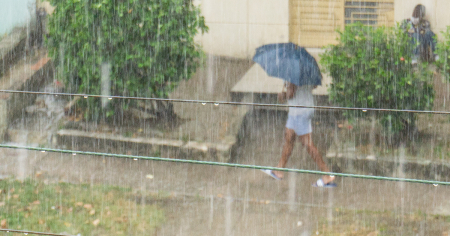The National Hurricane Center (NHC) of the United States published this Friday the official list of names for Atlantic tropical storms that will be used during the 2025 hurricane season, which will begin on June 1 and run until November 30.
"Since 1953, tropical storms in the Atlantic have been named from lists developed by the National Hurricane Center. Currently, an international committee of the World Meteorological Organization maintains and updates these lists," published the NHC on its official X account along with this year's list of names.
Official list of names for 2025
The tropical storms and hurricanes of the Atlantic in 2025 will carry the following names, in alphabetical order:
Andrea, Barry, Chantal, Dexter, Erin, Fernand, Gabrielle, Humberto, Imelda, Jerry, Karen, Lorenzo, Melissa, Nestor, Olga, Pablo, Rebekah, Sebastien, Tanya, Van, and Wendy.
This list is reused every six years, although the names of particularly destructive storms may be permanently removed.
Beryl, Helene, and Milton were withdrawn after a catastrophic season
This year, the World Meteorological Organization officially removed the names Beryl, Helene, and Milton from future lists due to their devastating impact during the 2024 hurricane season. They will be replaced in 2030 by Brianna, Holly, and Miguel.
The 2024 season set historical records for intensity, with 378 deaths and over 140 billion dollars in damages, severely impacting Cuba, the United States, and other Caribbean nations. A total of 18 named storms were recorded, including 11 hurricanes, 5 of which were major.
Cuba forecasts an active hurricane season with a high likelihood of impact
On May 7th, the Cuban Institute of Meteorology (INSMET) announced its official forecast for the 2025 hurricane season, which anticipates an active pattern with favorable conditions for the formation of tropical cyclones in the Atlantic, the Gulf of Mexico, and the Caribbean Sea.
According to the report, a total of 15 tropical cyclones are expected to form, of which 8 could reach hurricane status. Of these, 10 would form in the Atlantic, 3 in the Caribbean, and 2 in the Gulf of Mexico.
"The likelihood of at least one hurricane forming and intensifying in the Caribbean is high (75%), and the chance of one coming from the Atlantic entering the Caribbean is moderate (50%)," the text warns.
INSMET also warned that there is a 70% chance that at least one tropical storm will directly affect Cuba, which exceeds the historical average. The probability of a hurricane impacting the island is 35%.
International scientists anticipate even more storms
The forecast issued by Colorado State University (CSU), one of the most closely followed globally, agrees that the 2025 season will be more active than usual. According to CSU, 17 named storms, nine hurricanes, and four of major intensity (category 3 or higher on the Saffir-Simpson scale) are anticipated.
These figures surpass historical averages and reflect the continuation of a pattern of very high cyclonic activity in the Atlantic, particularly dangerous for the Caribbean islands and the southeastern United States.
Factors that influence cyclonic activity
Sea temperatures in the North Atlantic and the Caribbean remain high, increasing the risk of cyclonic development.
Additionally, the conditions associated with the La Niña phenomenon and the Southern Oscillation (ENSO) are another factor that can facilitate the development of storms. These patterns are expected to remain active during the central months of the season.
Filed under:
